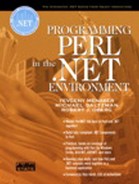Expressions
Internally, PerlNET uses Perl interpreter. This allows us to incorporate all the standard Perl features and expressions in our PerlNET programs. This means that all samples that we introduced in Part 1 may be compiled and executed in the .NET environment without any changes. Let us demonstrate this by a simple Core Perl program, the standard Perl script freq.pl for counting word occurrences, which we presented in Chapter 4. Here is the code for the script.
#
# freq.pl
#
while(<STDIN>)
{
@words = split;
foreach $word (@words)
{
$words{$word}++;
}
}
foreach $word (sort(keys(%words)))
{
print "$word occurred $words{$word}
";
}
Now, we may run the script either using Perl interpreter,
perl freq.pl
or by compiling into a .NET assembly and running the assembly:
plc freq.pl freq.exe < text.txt
In any case, we get the same result: All word occurrences in text from standard input are calculated and printed. Here is the output for both cases when the input was originated from the following file:
Almost everybody can learn Perl programming Not everybody likes to learn
Output:
Almost occurred 1 Not occurred 1 Perl occurred 1 can occurred 1 everybody occurred 2 learn occurred 2 likes occurred 1 programming occurred 1 to occurred 1
